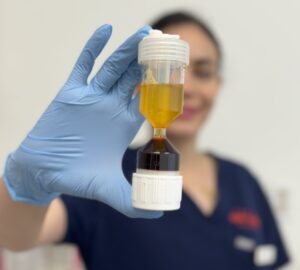Hair loss is a common issue faced by many individuals, and one area that is particularly affected is the crown of the head. The crown, also known as the vertex, is the topmost part of the head. It can suffer from anything ranging from a small visible gap to generalized thinning that spreads outward from the center. In this comprehensive guide, we will explore the aggressive solution to hair loss at the crown, including restoration and stabilization techniques, recovery, long-term strategies, and more.
Understanding the Crown Hair Loss
The crown area is prone to ongoing recession, especially in individuals experiencing male pattern baldness. This means that additional hair restoration sessions may be required in the future to cover further baldness that may occur in this area. It is important to note that individuals under 35 years of age may not be suitable candidates for crown hair transplantation, as the crown area will continue to lose hair over time and there may not be a sufficient amount of donor hair to cover the balding area in the future.
Crown Hair Transplant Procedure
1. Extensive Grafting for Excellent Results
Crown hair restoration requires an extensive number of grafts to achieve optimal outcomes. Depending on the extent of baldness, multiple sessions may be necessary to achieve the desired density. It is crucial to consult with a hair transplant specialist to determine the number of grafts and sessions required for your specific case.
2. Addressing Front and Crown Areas
If both the front and crown areas of the head experience significant hair loss, it is essential to address them separately to avoid unnatural results and lack of density. Unless a mega session (over 3,000 grafts) is performed, addressing the front, center, and crown areas simultaneously may not yield the desired outcome. The candidacy for this procedure should be evaluated to determine the most effective approach.
3. Medical Management for Crown Hair Transplant
Individuals considering crown hair restoration are advised to be on medical management, such as finasteride and/or minoxidil, to slow down further hair loss in the crown area. This proactive approach helps minimize the need for additional transplant sessions in the future. It is especially recommended for younger individuals contemplating crown hair transplantation.
Causes of Crown Hair Loss
Hair loss in the crown area is commonly associated with male pattern baldness in men. Women can also experience hair loss in this area due to various conditions, although the pattern is typically more dispersed. Some conditions that may result in crown hair loss include alopecia areata, anagen hair loss, cicatricial alopecias, disorders of hair growth, inflammatory scalp conditions, telogen hair loss, tinea capitis, traction alopecia, and trichotillomania. The nature and progression of these conditions determine the appropriate treatment, which may involve medication or surgical intervention. Dr. Jonathan Huber is trained to assess each case and recommend the safest and most successful treatment approach.
Determining whether hair restoration surgery is the best option for treating crown hair loss requires careful consideration of several factors. These include the extent of hair loss, the likelihood of future hair loss, the availability of sufficient donor hair to address new balding areas, and the ability to create natural-looking hair patterns through transplantation. During the initial consultation, you will receive expert advice on the most suitable crown hair restoration options for your specific situation.
Recovery from Crown Hair Transplant
Recovery from a crown hair transplant is similar to recovery from other types of hair transplant surgery. The recovery duration depends on the donor hair harvesting method (linear harvesting or follicular unit extraction), the size of the coverage area, and the number of grafts required. Generally, patients can resume most daily activities within 24 hours after surgery. However, it is advisable to avoid strenuous activities for about a week to prevent accidental injury and reduce the risk of bleeding.
Many individuals choose to take a few days off work following the procedure. During recovery, expect some scabbing in the transplanted area, which typically resolves within a week. There is no need for bandages; you can wash your hair the day following the surgery. If desired, you can wear a hat or cap immediately after surgery to conceal any scabs.
Cost of Crown Hair Transplantation
The cost of crown hair transplantation can vary significantly from patient to patient. Factors such as the area of hair loss to be covered and the desired hair density can influence the number of grafts required during the procedure. In some cases, multiple procedures may be necessary. The individualized nature of crown hair transplantation costs necessitates discussing the details during an initial consultation.
Hair Transplants FAQ
How much does a hair transplant cost?
The cost of a hair transplant depends on the procedure type and the number of grafts transplanted. Dr. Jonathan Huber focuses on manually performing the procedures for the most natural look possible. Hair transplant procedures generally start at $6,000.
Is it possible to achieve a natural-looking result?
Yes, Dr. Sharma’s artistic eye and years of experience ensure that the results of hair transplants look as natural as possible. The goal is to create a hairline that appears untouched by any surgical intervention.
What is the recovery process like?
After a hair transplant, patients typically experience swelling, tightness, and discomfort in the scalp. Temporary scabbing is also common during the healing process. Dr. Jonathan Huber provides after-care instructions and personal follow-ups to ensure a smooth recovery.
Talk to a Hair Transplant Expert
If you are considering hair restoration options for crown hair loss, our experienced team is here to assist you. Whether you are a Toronto resident or choosing our clinic as your hair transplant surgery destination, we are just a phone call away. Contact Toronto Hair Transplant to schedule a consultation and learn more about how our modern treatments can help you regain a confident, full head of hair.










